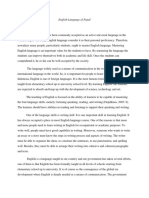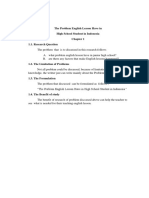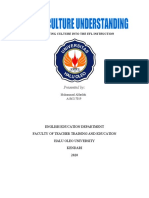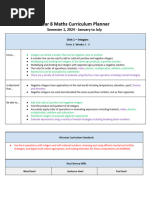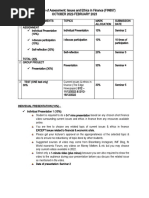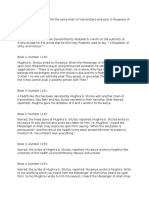Yaya
Yaya
Uploaded by
netta ivanaCopyright:
Available Formats
Yaya
Yaya
Uploaded by
netta ivanaOriginal Title
Copyright
Available Formats
Share this document
Did you find this document useful?
Is this content inappropriate?
Copyright:
Available Formats
Yaya
Yaya
Uploaded by
netta ivanaCopyright:
Available Formats
THE ROLE OF CCU IN ENGLISH CLASSROOM
IN INDONESIA
Hikmatulloh; Ahmad Syafi’i
STKIP Al Hikmah Surabaya; STKIP Al Hikmah Surabaya
hikmatulloh819@gmail.com; ahmadsyafii20@gmail.com
Abstract
Language cannot be separated from culture, so if we teach a language, we
also need to correlate it with culture. It implies that to teach language means to
also teach the culture. Since English now belongs to the world as lingua franca,
used by different nationalities, number of students who learn English increases
around the world. The increase of students who learn English in countries with
various ethnics make multicultural education in 21st century. This phenomenon
happens especially in diverse country such as Indonesia that has thousands of
ethnics, languages, religions, and cultures. Language and religious diversity is
also increasing among the nation’s student population (Dilg, 2003). ln an EFL
country such as Indonesia, teaching cross-cultural understanding (CCU) is
extremely needed in order to understand the language taught. This paper will
discuss the use of CCU in English classroom especially in Indonesia.
Keywords: culture, CCU, multicultural classroom
Introduction
As International language, English is taught around the world. Inner circle
countries such as The Great Britain, USA, and Australia learn English as the
primary language or the first language. Outer circle countries such as India,
Malaysia, and others learn English as a second language. Indonesia, however, as
an expanding country considers English as a foreign language.
The different use of English makes English teaching and learning different
among countries in the world. People in England might find it easy to learn
English because it is their own language, while in Indonesia, people find it very
difficult to learn English. Many of the difficulties faced by Indonesian students
deal with the social and cultural factors that they have in Indonesia, but Inner
circle society does not, or things that exist in Inner circle countries, but do not in
Indonesia.
Language cannot be separated from culture, so if we teach a language, we
also need to correlate it with culture. Since English now belongs to the world as
lingua franca, used by different nationalities, number of students who learn
English increases around the world.
The increase of students who learn English in countries with various
ethnics make multicultural education in 21st century. Language and religious
JELLT Vol.4, No.1 - 2020 59
diversity is also increasing among the nation’s student population (Dilg, 2003).
According to US Census Bureau (2000), sixteen percent of school-age youth lived
in homes in which English was not the first language in 1990. Most teachers now
in the classroom and in teacher education programmes are likely to have
students from diverse ethnic, racial, language, and religious groups in their
classrooms during their careers.
An important goal of multicultural education is to improve race relations
and to help all students acquire the knowledge, attitudes, and skills needed to
participate in cross-cultural interactions and in personal, social, and civic action
that will help make the nation more democratic and just.
Multicultural education is where a study is designed to equity in
education for all students. The contents of the study have to be appropriate to be
taught in a multicultural society. The social and behavioural contexts have to be
applicable for any ethnic or social paradigms.
In this paper, the writer will describe teaching English in multicultural
classroom in Indonesia.
Literature Review
Culture is the way of life, especially the general customs and beliefs, of a
particular group of people at a particular time (Cambridge Dictionary). Martin
and Nakayama (2010) consider culture as the core concept in intercultural
communication. While Kluckhohn and Kelly in Valdes (1996) define culture as
all those historically created designs for living, explicit or implicit, rational,
irrational, and non-rational, which exist at any given time as potential guides for
the behaviour of men.
Learning cross-cultural understanding is very important since
communication, language, and culture cannot be separated (Tomalin and
Stempleski, 1993). If we do not understand culture, we will not be able to
understand text fully (Sadtono, 1999). Shaules and Abe (1997:24) suggest that
‘learning to speak another language is also learning how to change our way of
looking at the world, and our way of thinking and interacting.’
In foreign language situations, the hundreds of thousands of learners of
English tend to have an instrumental motivation to learn the foreign language
(Broughton et.al, 1980). Language and religious diversity is also increasing
among the nation’s student population (Dilg, 2003). Teaching English as a
Foreign Language (TEFL) refers to teaching English to students whose first
language is not English. TEFL usually occurs in the student's own country, either
within the state school system, or in private institutions. TEFL teachers may be
native or non-native speakers of English (Rohmah, 2013).
Culture and cross-cultural understanding
As we can see from categorisation that culture is complicated. The simple
kind of culture consists of material culture (human’s products), social culture,
JELLT Vol.4, No.1 - 2020 60
and ideological culture. It is categorised more complexly into hidden
(unnoticeable culture), deep culture (values), time oriented culture, gender-
oriented culture, involvement culture and context culture.
The need of studying CCU for language learners
It is a well acceptable fact that language cannot be separated from
culture. In order to be able to communicate fluently, cultural and linguistic
aspect should be considered. In fact, if we want to learn a foreign language, we
need to learn the culture too. For example, when we learn English vocabulary
such as Thanksgiving, Barbeque, Halloween, etc., we will not understand them
all unless we know what they are according to English culture. In Indonesian
classrooms, as the alternative, the teachers might compare those cultural things
in accordance to Indonesian cultures, i. e. Sedekah Bumi as comparison to
Thanksgiving, Satai to Barbeque, and Bekakak to Halloween.
Moreover, cultural patterns, customs, and ways of life are considered as
parts of language expression. When we read a text in another language, we are
also learning that culture. As the consequence, when we do not understand the
culture, we will not be able to understand the text deeply.
Learning another language also means that we learn how to look at the
world, putting aside our way of thinking and interacting. A person who is expert
in many cultures will be more acceptable in any circumstance and environment.
That makes the person easy to communicate with the society, so the language
acquisition is far more achievable.
It is approved that to study a language, we also need to study the culture.
To study the culture, we cannot describe it in another culture, which means it
can only be understood on its own term. In other words, there is no single
culture that is acceptable to universal perception. For example, in Jordan, family
members can kill one of them to protect the honour of the family (Time, 1999).
This sort of culture or belief or value of course cannot be accepted by some other
cultures such as Indonesia.
Goals of CCU
The role of CCU in TEFL (Teaching English as Foreign Language) has a
significant influence. There are at least four goals of CCU for Indonesian learners,
namely:
For those who are going to become teachers of English
For those who are going overseas to live or study for a lengthy period of
time
For those who are going overseas to live or study for a brief period
For those who will never go overseas but they will mainly read English
materials or work in a company where they have to deal with foreigners.
JELLT Vol.4, No.1 - 2020 61
Problems for learners of EFL
As lingua franca, English now is spoken and written by various
nationalities in the whole world, so it cannot be claimed by any speaker of
particular nationality. The question now is “what culture do the learners have to
learn when learning English?” If they plan to visit a certain English speaking
country such as Britain, the answer will be very simple. However, most students
in Indonesia do not know or perhaps do not plan to visit any of those countries.
Some will probably visit non-English speaking countries instead.
In reading, however, the biggest problem dealing with CCU is
understanding terms that come from cultural aspect and do not exist in the
learners’ first language. Learners with little knowledge of CCU will find it very
difficult to recognise the words.
Another problem in CCU is different style of communication. In the USA
on Monday mornings, people usually ask about how we spend our week-ends,
for example "Did you enjoy your week-end?" In Indonesia, in contrast, it is hard
to find people asking such a question. In Javanese culture, people usually ask
'Where are you going?’ when other people pass their houses. That question will
be probably considered impolite and nosey in USA. Another feature is idiomatic
style. Words such as “malu-malu kucing” in Indonesian culture, for example, will
be translated as “shy-shy cat”, and “buka puasa” which is generally used by
Muslim students as “open fasting”.
Other important problems in cross-cultural communication are the
verbal patterns as follows:
rules of style and speaking (formal, semi-formal and formal)
In Sundanese culture (one of the ethnics in Indonesia), people also know the
divisions of communicating styles as in English. They recognise the term “basa
alus” as formal, “basa loma” as semi-formal, and “basa kasar” as informal. The
difference between English and Sundanese style, however, is in the way the
style transforms. In English, people speak formal when they say please, would,
could, etc., while in Sundanese, people tend to have different vocabulary for
each level of formality.
criticising
In general Indonesian cultures, people are not supposed to critisise what
other people do, even when it is wrong. Instead of giving critics about someone,
Indonesian people had better to “lie”, saying everything is fine and good.
refusing (food)
When someone offers some food, Indonesian people will commonly refuse it
by saying “Iya, silakan”, or “Monggo” in Javanese and even “Mangga” in
Sundanese which is translated into “Yes, please” in English. However, if
someone says such a thing in English, it means he/she does not refuse it, but
accepts it.
JELLT Vol.4, No.1 - 2020 62
Having different cultures in learning foreign language is less severe than
having different structures. This difference will cause many complications when
learners read English writing. If they feel difficult in grammar, they can check it
in grammar book. Differently, there is nothing to do when it comes to different
cultures. There is not any reference to refer to.
There are still some problems that the learners face when learning
foreign language, such as gestures, facial expressions, eye contact, and space.
Those problems deal with deep culture.
Conclusion
Since English now is international language, it is very important to teach
students around the globe, whose first language is not English, cross-cultural
understanding. This is because culture is considered as the core of language. It
means that when we learn a language, we need also to learn the culture of the
speakers of that language.
Furthermore, the writer presents some problems that we need to
consider in CCU classroom in TEFL. Many learners are still confused while
studying CCU. As non-native English speakers, it is hard to identify the cultural
aspects that the learners might find while they are learning English. The best
alternative to that problem is to compare some cultural words in English into
things that they might be more famous to them. Then, in what aspects of
language the learners should be involved in? To answer this question, we need
to analyse their needs that can be divided into: to be English teachers, to live in
countries where English is spoken in, to travel, and the need to study in which
English textbook is used.
JELLT Vol.4, No.1 - 2020 63
References
Broughton, Geoffrey, et al. (1978). Teaching English as A Foreign Language. New
York: Routledge
Dilg, Mary. (2003). Thriving in The Multicultural Classroom. New York: Teachers
College Press
Martin, J. N. And Nakayama, T. K. (2010). Intercultural Communication in
Contexts. New York: McGraw-Hill
Rohmah, Zuliati. (2013). Teaching English as A Foreign Language. Surabaya: UIN
Sunan Ampel Surabaya
Sadtono, E. (1999). Some Problems in Teaching Cross-cultural Understanding in
EFL Countries with Particular Reference to Indonesia. NUCB Journal of
Language, Culture and Communication, 1 (3).
Sadtono, E. (2003). Cross-cultural Understanding: A Dilemma for TEFL. TEFLIN
Journal, 14(1), 83-110.
Shaules, J and Abe, J. (1997). Different Realities. Tokyo: Nan’un-do
Tomalin, E. & Stempleski, S. (1993). Cultural Awareness. Oxford: Oxford
University Press
Valdes, J. M. (1986). Culture Bound. Cambridge: Cambridge university Press
JELLT Vol.4, No.1 - 2020 64
You might also like
- AQA GCSE ENGLISH LITERATURE Including 2022Document9 pagesAQA GCSE ENGLISH LITERATURE Including 2022Keerthy verNo ratings yet
- Senior Software Developer ResumeDocument6 pagesSenior Software Developer Resumef60pk9dc100% (2)
- Frauwallner Erich - Philosophy of Buddhism PDFDocument300 pagesFrauwallner Erich - Philosophy of Buddhism PDFnimfaea67% (3)
- Carl Ernst-What Is A Sufi OrderDocument9 pagesCarl Ernst-What Is A Sufi OrderibnshaadiNo ratings yet
- Geertz - Under The Mosquito NetDocument11 pagesGeertz - Under The Mosquito Netaalvarez501100% (1)
- CCU Salsabila A.P C9Document6 pagesCCU Salsabila A.P C9Salsabila PutriNo ratings yet
- Comparing Indonesian and English Culture Cfefb1d0Document16 pagesComparing Indonesian and English Culture Cfefb1d0cealse.ssNo ratings yet
- English Literature and Language ReviewDocument6 pagesEnglish Literature and Language ReviewTHEA URSULA EMANUELLE RACUYANo ratings yet
- Jurnal Nasional ELT in Focus - Fauzi MiftakhDocument10 pagesJurnal Nasional ELT in Focus - Fauzi MiftakhFauzi MiftakhNo ratings yet
- M Nur Ikhsan 218 110 010Document14 pagesM Nur Ikhsan 218 110 010IKHSAN TVNo ratings yet
- Teaching of English in India Problems and ProspectsDocument4 pagesTeaching of English in India Problems and ProspectsShweta kashyapNo ratings yet
- Teaching English in IndiaDocument6 pagesTeaching English in Indiahellme9865No ratings yet
- Mid Test Essay - Dian Novita 19070956005 - Revised 25 MarchDocument5 pagesMid Test Essay - Dian Novita 19070956005 - Revised 25 Marcharinal khaqqoNo ratings yet
- Chapter One: Literature ReviewDocument25 pagesChapter One: Literature ReviewNassim MeniaNo ratings yet
- Interculturality Native-Speakerism and Authenticity Paradoxes in Indonesia S EFL PedagogyDocument22 pagesInterculturality Native-Speakerism and Authenticity Paradoxes in Indonesia S EFL PedagogyRefi Ranto RozakNo ratings yet
- Sociolinguistics - Tugas 3Document4 pagesSociolinguistics - Tugas 3atapberceritaNo ratings yet
- Critical Perspectives in ELT 1" " Discussing Issues Related To The Curriculum and Literacy in ELT"Document3 pagesCritical Perspectives in ELT 1" " Discussing Issues Related To The Curriculum and Literacy in ELT"Asti SitiNo ratings yet
- Final Exam Elt (Ra)Document18 pagesFinal Exam Elt (Ra)Luthfy HamizanNo ratings yet
- Paper CcuDocument10 pagesPaper CcuMarsya Cha RichaNo ratings yet
- The Relationship Between LanguageDocument6 pagesThe Relationship Between LanguageJedibabe100% (1)
- Importance of English Language and LiteratureDocument9 pagesImportance of English Language and LiteratureMallika VermaNo ratings yet
- IntegritasDocument35 pagesIntegritasIvan MaulanaNo ratings yet
- 238 MidtermDocument8 pages238 Midtermapi-533970494No ratings yet
- Sample - Argumentation.YL - GLOBAL ENGLISHES PARADIGM OF EFL TEXTBOOK FOR INDONESIAN LEARNERS IN THE INDONESIAN CONTEXTDocument6 pagesSample - Argumentation.YL - GLOBAL ENGLISHES PARADIGM OF EFL TEXTBOOK FOR INDONESIAN LEARNERS IN THE INDONESIAN CONTEXTmaun92No ratings yet
- Esaay EnglishDocument3 pagesEsaay EnglishNita DwihapsariNo ratings yet
- 4706 10087 1 SMDocument10 pages4706 10087 1 SMLylia Mez100% (1)
- 51 2 4 Neff RucynskiDocument12 pages51 2 4 Neff Rucynskisonu thigleNo ratings yet
- The Role of The English TeacherDocument7 pagesThe Role of The English TeacherVidya PatilNo ratings yet
- IJCRT22A6335Document7 pagesIJCRT22A6335Pulkesh PulakNo ratings yet
- Unit 1Document25 pagesUnit 1Kiran SoniNo ratings yet
- Aulia Rizqina Observation Report of Cross Culture UnderstandingDocument7 pagesAulia Rizqina Observation Report of Cross Culture UnderstandingAULIA RIZQINANo ratings yet
- Guide 94 02Document19 pagesGuide 94 02Putry Muthiah IshaqNo ratings yet
- Critique PaperDocument5 pagesCritique PaperLovely Deins AguilarNo ratings yet
- Group 2 FinaleDocument34 pagesGroup 2 FinalePrincess-Najeb EmEs Sharief-TomagaNo ratings yet
- Teachlangalongwithculture LiesUNESAREVDocument14 pagesTeachlangalongwithculture LiesUNESAREVLâm ThưNo ratings yet
- English Subject Curriculum-6Document11 pagesEnglish Subject Curriculum-6api-189825095No ratings yet
- The Importance of World Englishes in Language EducationDocument5 pagesThe Importance of World Englishes in Language EducationResearch ParkNo ratings yet
- EIL PAPER Wahyu Wardani 157835444Document13 pagesEIL PAPER Wahyu Wardani 157835444dhianingwahyu sugiartoNo ratings yet
- Curriculum StudiesDocument10 pagesCurriculum Studiesntigyabaah22No ratings yet
- Why Junior High Student That Not Native English Speaker Dislike Engish LessonDocument6 pagesWhy Junior High Student That Not Native English Speaker Dislike Engish LessonZainul AsnaNo ratings yet
- Motivation of English Learning and Intercultural Communication: A Case of Indonesian College StudentsDocument11 pagesMotivation of English Learning and Intercultural Communication: A Case of Indonesian College Studentsarin vanNo ratings yet
- Conceptual Article (LCD)Document7 pagesConceptual Article (LCD)Neny FebrianaNo ratings yet
- Tiếng-anh-trên-thế-giới-CKDocument4 pagesTiếng-anh-trên-thế-giới-CKMinh Phương HoàngNo ratings yet
- The Role of Culture in Teaching and Learning of English As A Foreign LanguageDocument14 pagesThe Role of Culture in Teaching and Learning of English As A Foreign LanguageKhoa NguyenNo ratings yet
- Education Policy and Efl Curriculum in Indonesia: Between The Commitment To Competence and The Quest For Higher Test ScoresDocument14 pagesEducation Policy and Efl Curriculum in Indonesia: Between The Commitment To Competence and The Quest For Higher Test ScoresDewa KasumajayaNo ratings yet
- 49 1 4 Milambiling-1Document9 pages49 1 4 Milambiling-1Juan Santiago BotelloNo ratings yet
- Bc210210595 ENG506 Assignment 1 Solution 2024Document2 pagesBc210210595 ENG506 Assignment 1 Solution 2024junaidmian304No ratings yet
- Cross Cultural Contexts in English Language Teaching Ingrid Brita MatthewDocument6 pagesCross Cultural Contexts in English Language Teaching Ingrid Brita MatthewSausan KeikoNo ratings yet
- Intercultural Communicative Competence EDocument9 pagesIntercultural Communicative Competence ECäsar ArenasNo ratings yet
- Teaching in Multilingual N Multicultural ClassroomsDocument3 pagesTeaching in Multilingual N Multicultural ClassroomsBaby PandaNo ratings yet
- SP Research Paper Final DraftDocument12 pagesSP Research Paper Final Draftapi-610115795No ratings yet
- Presented By:: Integrating Culture Into The Efl InstructionDocument12 pagesPresented By:: Integrating Culture Into The Efl InstructionAlffa RizNo ratings yet
- Assignment 3 EssayDocument6 pagesAssignment 3 Essayapi-298379083No ratings yet
- Indeginous Languages Teaching NotesDocument23 pagesIndeginous Languages Teaching Noteseliekips96100% (8)
- Tugas 3 Sociolinguistics PDFDocument3 pagesTugas 3 Sociolinguistics PDFCitta Setiarti100% (1)
- Why Teaching Culture Is Important in EFL Setting Tran Thi Thanh QuyenDocument15 pagesWhy Teaching Culture Is Important in EFL Setting Tran Thi Thanh QuyenLylia MezNo ratings yet
- Case Study Analysis (Final)Document3 pagesCase Study Analysis (Final)Robert PalabayNo ratings yet
- English Language Education in Indonesia A Review of Research 2011 2019Document33 pagesEnglish Language Education in Indonesia A Review of Research 2011 2019Elvina ArapahNo ratings yet
- Distinction Between English and Bahasa Indonesia A PaperDocument9 pagesDistinction Between English and Bahasa Indonesia A PaperAgum FajarNo ratings yet
- Cultural Elements in Malaysian English Language Textbooks - My - CaseltDocument22 pagesCultural Elements in Malaysian English Language Textbooks - My - CaseltNataliaJohnNo ratings yet
- Individual EssayDocument3 pagesIndividual Essayvioleta burgosNo ratings yet
- How Sociolinguistics Influences English TeachingDocument5 pagesHow Sociolinguistics Influences English Teachinghan3mi6yangNo ratings yet
- Gramática 1Document1 pageGramática 1Sofia LourençoNo ratings yet
- SDMX Reference Architecture v1Document20 pagesSDMX Reference Architecture v1Vishal BiseswarNo ratings yet
- American Literature Thesis TopicsDocument4 pagesAmerican Literature Thesis Topicsfczeohief100% (2)
- Analyzing Esxtop ColumnsDocument3 pagesAnalyzing Esxtop ColumnsTomas BonNo ratings yet
- Feedback On Pedro's Practice Test BDocument4 pagesFeedback On Pedro's Practice Test BFITAMERICA COBRASNo ratings yet
- Arduino Solar Meter Software Manual V11Document17 pagesArduino Solar Meter Software Manual V11Ailton Façanha MoreiraNo ratings yet
- Ingge Project EditedDocument14 pagesIngge Project EditedTop CentersyncNo ratings yet
- B.ing EksposisiDocument13 pagesB.ing Eksposisihermanto prastyawanNo ratings yet
- NetWorker Cloning Integration GuideDocument100 pagesNetWorker Cloning Integration GuideMalyaj ShankerNo ratings yet
- FDBMSDocument26 pagesFDBMSsurendraNo ratings yet
- IGNOU OPENMAT 2019 Question PaperDocument87 pagesIGNOU OPENMAT 2019 Question PaperMufaddal DaginawalaNo ratings yet
- Semester One - 2024 - Year 8 MathsDocument19 pagesSemester One - 2024 - Year 8 Mathsbp5573373No ratings yet
- Madhyanchal Vidyut Vitaran Nigam Ltd. Lucknow (MVVNL) _ DirectoryDocument4 pagesMadhyanchal Vidyut Vitaran Nigam Ltd. Lucknow (MVVNL) _ DirectoryassgxNo ratings yet
- Summary of Assessment FIN657 October 2022 February 2023Document4 pagesSummary of Assessment FIN657 October 2022 February 2023AZRUL IKHWAN AZMINo ratings yet
- Ibn Numair NarratedDocument6 pagesIbn Numair NarratedEzmel KazimNo ratings yet
- Sentences Direct and Indirect SpeechDocument3 pagesSentences Direct and Indirect SpeechWahyu Ari DewataNo ratings yet
- Software Programming Project and Report WritingDocument9 pagesSoftware Programming Project and Report Writingslokesh12289No ratings yet
- Body Language and Feelings American English StudentDocument7 pagesBody Language and Feelings American English StudentEnglish TeacherNo ratings yet
- CL IF-Clauses - Type 2 - PDF Grammar Worksheet - B1 - IF011Document1 pageCL IF-Clauses - Type 2 - PDF Grammar Worksheet - B1 - IF011Carmen OrtizNo ratings yet
- Recipe BookDocument29 pagesRecipe BookfoodprinteuNo ratings yet
- Matrix TheoryDocument23 pagesMatrix TheorySCRIBDSNo ratings yet
- SQL Queries For Practice - Advanced SQL Queries PDFDocument15 pagesSQL Queries For Practice - Advanced SQL Queries PDFbazezewNo ratings yet
- PLate Impact Based On Johnson Cook ParametersDocument33 pagesPLate Impact Based On Johnson Cook ParametersTaiwo OlasumboyeNo ratings yet
- Interaction of Logical and Nominal Meanings. Peculiar Use of Set ExpressionsDocument10 pagesInteraction of Logical and Nominal Meanings. Peculiar Use of Set ExpressionsPolina LysenkoNo ratings yet
- The Ghost OriginalDocument13 pagesThe Ghost OriginalRosa ReynosoNo ratings yet
































